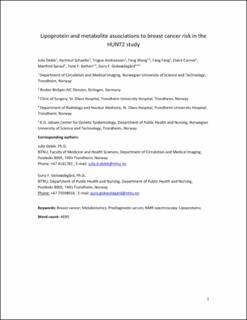| dc.contributor.author | Debik, Julia | |
| dc.contributor.author | Schäfer, Hartmut | |
| dc.contributor.author | Andreassen, Trygve | |
| dc.contributor.author | Wang, Feng | |
| dc.contributor.author | Fang, Fang | |
| dc.contributor.author | Cannet, Claire | |
| dc.contributor.author | Spraul, Manfred | |
| dc.contributor.author | Bathen, Tone Frost | |
| dc.contributor.author | Giskeødegård, Guro F. | |
| dc.date.accessioned | 2023-04-13T11:32:19Z | |
| dc.date.available | 2023-04-13T11:32:19Z | |
| dc.date.created | 2022-10-24T14:02:37Z | |
| dc.date.issued | 2022 | |
| dc.identifier.citation | British Journal of Cancer. 2022, 127 1515-1524. | en_US |
| dc.identifier.issn | 0007-0920 | |
| dc.identifier.uri | https://hdl.handle.net/11250/3062882 | |
| dc.description.abstract | Background
The aim of this study was to gain an increased understanding of the aetiology of breast cancer, by investigating possible associations between serum lipoprotein subfractions and metabolites and the long-term risk of developing the disease.
Methods
From a cohort of 65,200 participants within the Trøndelag Health Study (HUNT study), we identified all women who developed breast cancer within a 22-year follow-up period. Using nuclear magnetic resonance (NMR) spectroscopy, 28 metabolites and 89 lipoprotein subfractions were quantified from prediagnostic serum samples of future breast cancer patients and matching controls (n = 1199 case–control pairs).
Results
Among premenopausal women (554 cases) 14 lipoprotein subfractions were associated with long-term breast cancer risk. In specific, different subfractions of VLDL particles (in particular VLDL-2, VLDL-3 and VLDL-4) were inversely associated with breast cancer. In addition, inverse associations were detected for total serum triglyceride levels and HDL-4 triglycerides. No significant association was found in postmenopausal women.
Conclusions
We identified several associations between lipoprotein subfractions and long-term risk of breast cancer in premenopausal women. Inverse associations between several VLDL subfractions and breast cancer risk were found, revealing an altered metabolism in the endogenous lipid pathway many years prior to a breast cancer diagnosis. | en_US |
| dc.language.iso | eng | en_US |
| dc.publisher | Springer Nature | en_US |
| dc.title | Lipoprotein and metabolite associations to breast cancer risk in the HUNT2 study | en_US |
| dc.title.alternative | Lipoprotein and metabolite associations to breast cancer risk in the HUNT2 study | en_US |
| dc.type | Peer reviewed | en_US |
| dc.type | Journal article | en_US |
| dc.description.version | acceptedVersion | en_US |
| dc.source.pagenumber | 1515-1524 | en_US |
| dc.source.volume | 127 | en_US |
| dc.source.journal | British Journal of Cancer | en_US |
| dc.identifier.doi | 10.1038/s41416-022-01924-1 | |
| dc.identifier.cristin | 2064477 | |
| cristin.ispublished | true | |
| cristin.fulltext | postprint | |
| cristin.qualitycode | 2 | |
